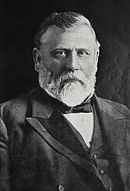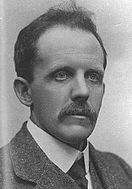1905 New Zealand general election
| |||||||||||||||||||||||||||||||||||||||||||||||||
All 80 seats in the New Zealand House of Representatives 41 seats were needed for a majority | |||||||||||||||||||||||||||||||||||||||||||||||||
|---|---|---|---|---|---|---|---|---|---|---|---|---|---|---|---|---|---|---|---|---|---|---|---|---|---|---|---|---|---|---|---|---|---|---|---|---|---|---|---|---|---|---|---|---|---|---|---|---|---|
| Turnout | 83.3% | ||||||||||||||||||||||||||||||||||||||||||||||||
| |||||||||||||||||||||||||||||||||||||||||||||||||
| |||||||||||||||||||||||||||||||||||||||||||||||||
The New Zealand general election of 1905 was held on Wednesday, 6 December in the general electorates, and on Wednesday, 20 December in the Māori electorates to elect a total of 80 MPs to the 16th session of the New Zealand Parliament. A total number of 412,702 voters turned out, with 396,657 (83.25% of the electoral roll) voting in the European electorates.[1][2][3]
Changes to the electoral law
The 1903 City Single Electorates Act declared that at the dissolution of the 15th Parliament, the four multi-member electorates would be abolished and replaced each with three single-member electorates.[4] It was also the year absentee voting was introduced for all electors unable to be in their own electorate on election day. The first Chief Electoral Officer was appointed.
Accordingly, the multi-member urban electorates of City of Auckland, City of Christchurch, City of Dunedin and City of Wellington were abolished and replaced with the following single-member seats:
- Auckland Central
- Auckland East
- Auckland West
- Christchurch East
- Christchurch North
- Christchurch South
- Wellington Central
- Wellington East
- Wellington North
- Dunedin Central
- Dunedin North
- Dunedin South
Nine of these twelve electorates had existed before. Wellington Central, Wellington North, and Dunedin North were established for the first time.[5]
Historic context
In 1905 a progressive faction within the Liberal Party started to form in opposition to Liberal leader Richard Seddon's policies. They announced that they would stand in the election as the New Liberal Party, however an accusation against Seddon's son, when disproven saw most of the dissidents return to the Liberal Party, and of the four New Liberals (George Laurenson, Francis Fisher, Harry Bedford and Tommy Taylor) that stood in the election only Laurenson and Fisher were returned.
The freshly created Independent Political Labour League also contested the election as a breakaway faction from the Liberals. It was the first of many steps of a gradual move by urban labourers shifting allegiance to an independent working-class political party. Previously, most workers had supported the Liberal Party, which since the 1890s had attempted to gain Trade Union support by appointing union representatives to the party's governing body. The IPLL did not perform well, gaining only 3,478 votes nationwide with no candidates elected.[6]
The Rev Frank Isitt was the Prohibition candidate for several South Island electorates, and came second in two.
Results

Party totals
The following table gives party strengths and vote distribution.[7]
style="width: 2px; background-color: #FFDF00;" data-sort-value="New Zealand Liberal Party" | style="width: 2px; background-color: #9999CC;" data-sort-value="Conservative (New Zealand)" | style="width: 2px; background-color: #DDBB00;" data-sort-value="New Liberal Party (New Zealand)" | style="width: 2px; background-color: #CC0033;" data-sort-value="Independent Political Labour League" | style="width: 2px; background-color: #DCDCDC;" data-sort-value="Independent politician" || Election results | ||||||
|---|---|---|---|---|---|---|
| Party | Candidates | Total votes | Percentage | Seats won | Change | |
| Liberal | 94 | 219,144 | 53.1 | 58 | +11 | |
| Conservative | 63 | 122,572 | 29.7 | 16 | -3 | |
| New Liberal | 7 | 15,721 | 3.8 | 2 | +2 | |
| Ind. Labour League | 9 | 3,478 | 0.8 | 0 | ±0 | |
| Independent | 63 | 51,785 | 12.5 | 4 | -10 | |
Votes summary
Electorate results
Template:1905 New Zealand general election
Notes
- ^ "New Zealand Elections 1905-1943". NZES. Retrieved 13 August 2011.
- ^ "General elections 1853-2005 - dates & turnout". Elections New Zealand. Archived from the original on 14 November 2014. Retrieved 12 January 2011.
- ^ "Results of the Polls". Ashburton Guardian. 7 December 1905. p. 2. Retrieved 24 August 2011.
- ^ McRobie 1989, p. 67.
- ^ Wilson 1985, pp. 262, 276.
- ^ Paul 1946, p. 176.
- ^ Wilson 1985, pp. 287–289.
References
- McRobie, Alan (1989). Electoral Atlas of New Zealand. Wellington: GP Books. ISBN 0-477-01384-8.
{{cite book}}: Invalid|ref=harv(help) - Wilson, James Oakley (1985) [First published in 1913]. New Zealand Parliamentary Record, 1840–1984 (4th ed.). Wellington: V.R. Ward, Govt. Printer. OCLC 154283103.
{{cite book}}: Invalid|ref=harv(help) - Paul, J.T. (1946). Humanism in Politics. Wellington: NZ Working Printing & Publishing.



